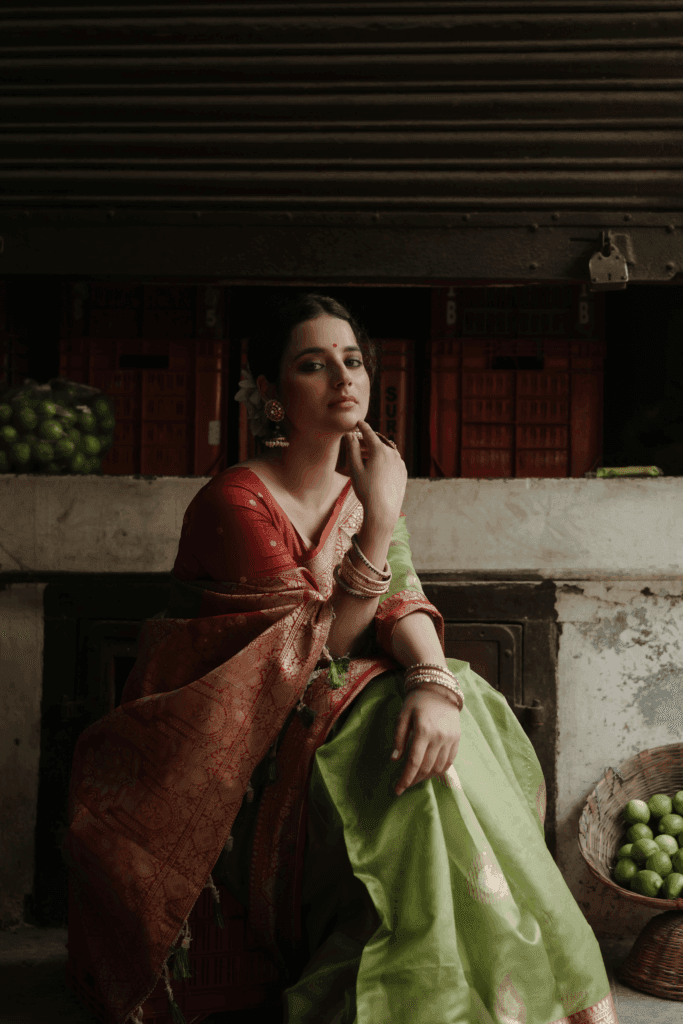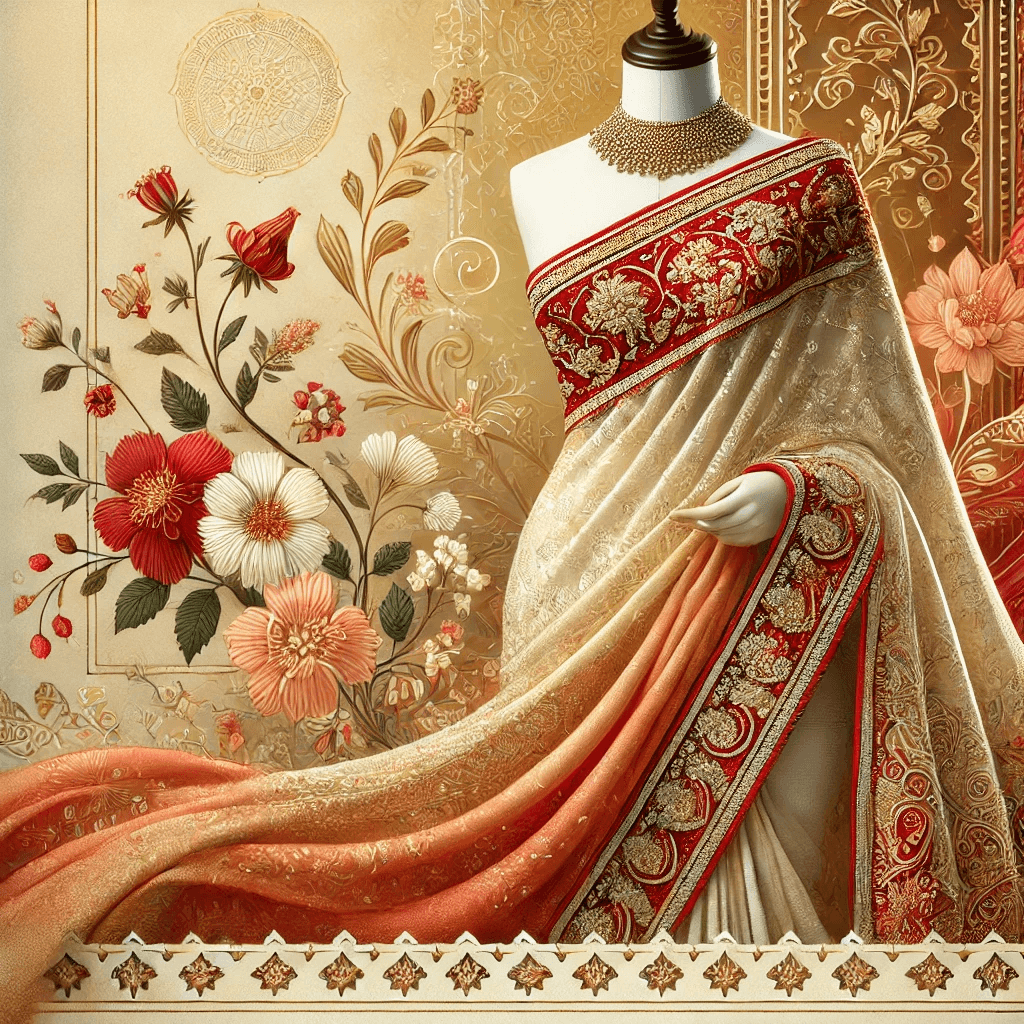- Aalta: The Sacred Red Adornment
- What is Aalta?
- The Ritual and Religious Significance of Aalta Shringar
- Aalta in Classical Dance and Performance
- The Modern Relevance of Aalta
- How to Apply Aalta: Step-by-Step
- Aalta Shringar in Traditional and Modern Saree Looks
- Classic Aalta Designs
- Artistic Variations
- Fusion & Modern Twists
- Aalta vs Mehendi: Which One to Choose?
- Sustainability and Cultural Continuity
- Conclusion: The Eternal Red of Tradition
Aalta: The Sacred Red Adornment
In Indian culture, red holds a great significan—it is a symbol of love, energy, fertility, and devotion. Among the many adornments that celebrate the spirit of femininity, Aalta Shringar holds a special place. Aalta is a deep red liquid dye. Women Apply it on the feet and sometimes the hands. Traditionally, aalta is an auspicious part of bridal makeup and festive beautification.
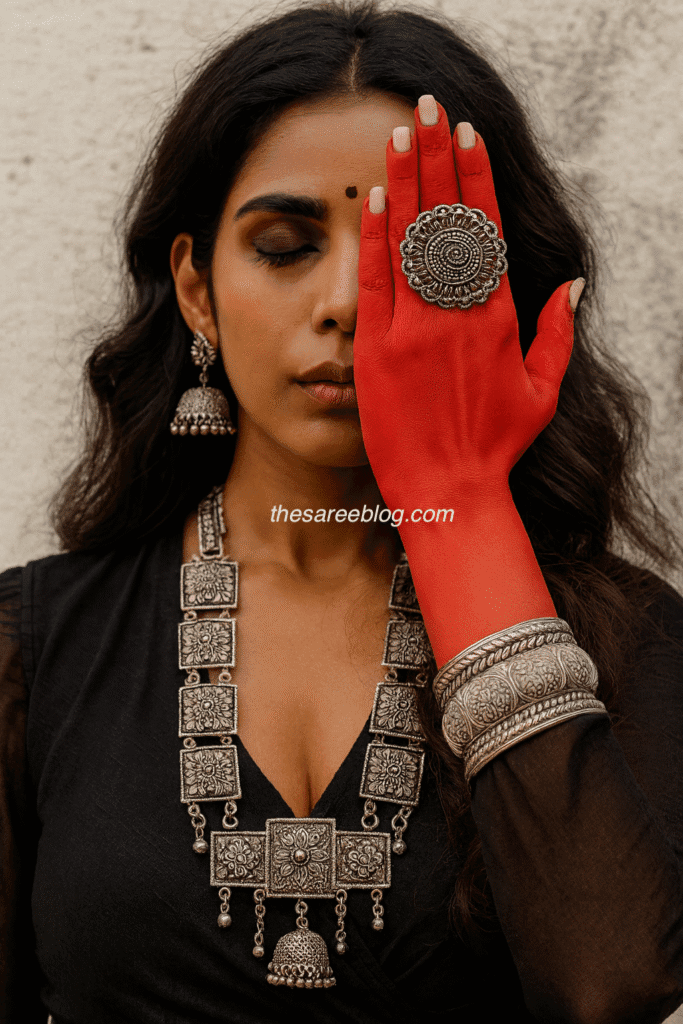
For centuries, Indian women have embraced Aalta Shringar not just as decoration but as an expression of cultural identity, ritual significance, and artistic beauty. Even today, in parts of Bengal, Odisha, Assam, and Uttar Pradesh, aalta continues to flow across festivals, weddings, and classical dance performances.
What is Aalta?
Aalta is a bright red liquid dye made traditionally from lac (a resin secreted by insects) and later from synthetic substitutes. Women apply it on the soles of the feet, toes, and edges of the hands with the help of cotton, brush, or simply by dipping fingers. The stain leaves a striking crimson imprint that enhances the beauty of traditional attire, especially sarees.

Where henna or mehendi brings intricate patterns, aalta brings boldness. Its plain yet powerful appearance is what makes it so unique in Indian adornment rituals.
The Ritual and Religious Significance of Aalta Shringar
1. Symbol of Auspiciousness
In Hindu rituals, red signifies shakti (power), fertility, and marital bliss. Aalta applied on the feet is believed to invoke prosperity and protection. Brides often wear it during their wedding ceremony to symbolize a new beginning filled with abundance.
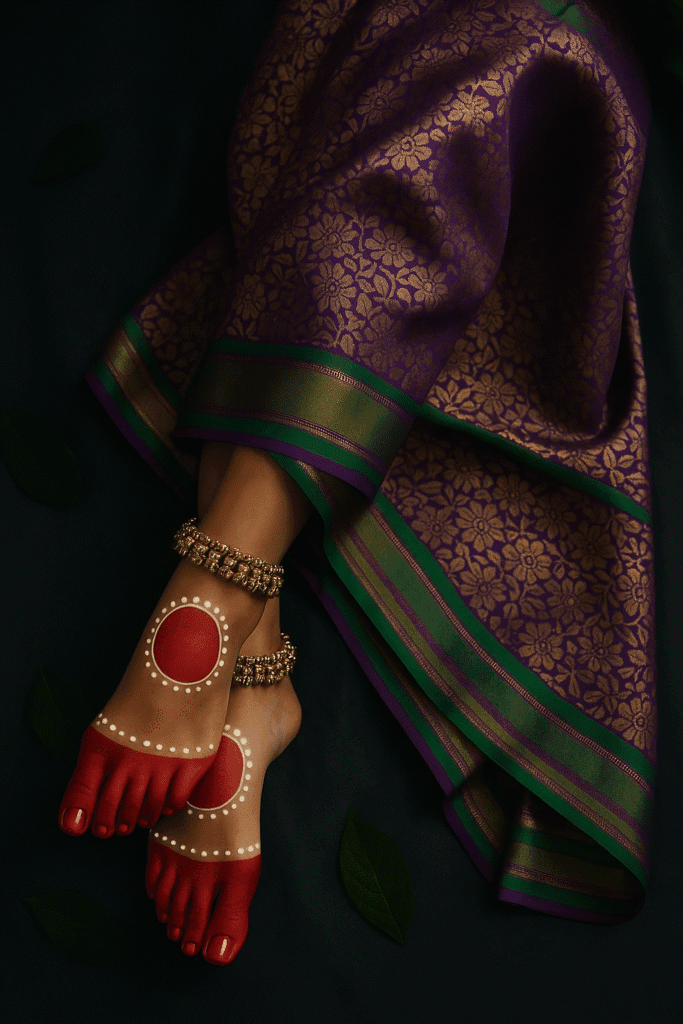
2. Association with Goddess Lakshmi
Feet decorated with aalta are often compared to those of Indian Goddesses.
3. Festivals and Religious Observances
- Durga Puja in Bengal: Married women perform Sindoor Khela and often adorn their feet with aalta.
- Jagannath Rath Yatra in Odisha: Devotees and dancers wear aalta as part of traditional rituals.
- Karwa Chauth and Teej: Women in northern India enhance their festive look with aalta along with bangles, sindoor, and sarees.
Aalta in Classical Dance and Performance
Beyond rituals, aalta has a strong association with Indian classical dance forms.
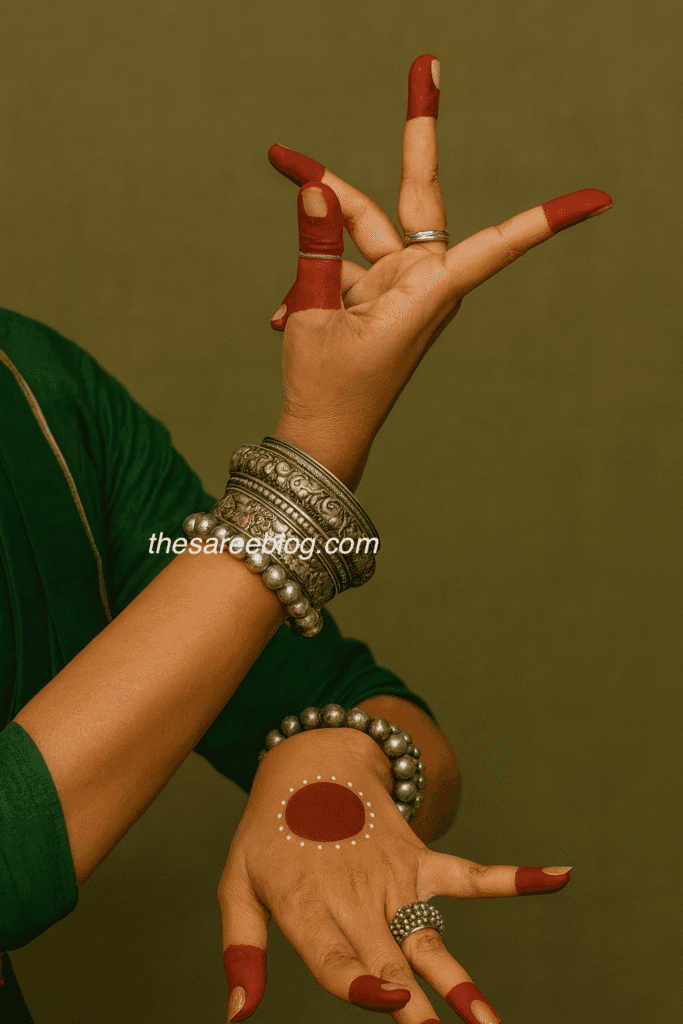
- Odissi Dance: Odissi dancers apply aalta on hands and feet, creating beautiful patterns that highlight hand gestures (mudras) and footwork (pada bheda).
- Kathak: Dancers use aalta to draw attention to their rhythmic movements during tatkaar.
- Bharatanatyam and Kuchipudi: Although mehendi is used occasionally, aalta remains a striking alternative for accentuating expression through movement.
The deep red shade against golden anklets and ghungroos creates a mesmerizing visual effect on stage.
The Modern Relevance of Aalta
Though urban lifestyles have reduced its everyday use, aalta still thrives in cultural spaces. Many women prefer mehendi or nail polish today, but during weddings and festivals, aalta regains its charm.
Fashion photographers and stylists now use Aalta Shringar to bring authenticity to traditional looks in bridal shoots. Saree bloggers, classical performers, and cultural influencers have revived its appeal on social media.
How to Apply Aalta: Step-by-Step
- Prepare the feet/hands – Wash and dry thoroughly.
- Choose your applicator – Cotton balls, brush, or fingertip.
- Dip and apply – Start from the toes, draw along the edges, and fill the centre if desired.
- Allow to dry – Let the feet rest for 10–15 minutes before walking.
- Pair with jewelry – Toe rings, anklets, and payals enhance the beauty of aalta-stained feet.
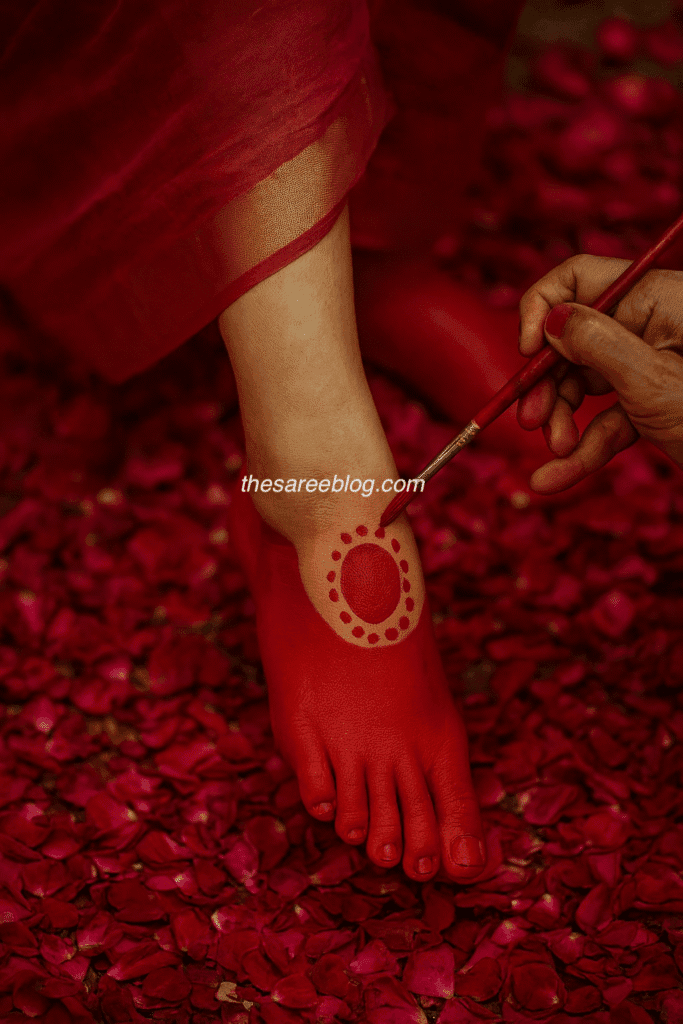
Pro Tip: Apply a thin layer of coconut oil before using aalta for smoother application and easy removal.
Aalta Shringar in Traditional and Modern Saree Looks
Here are some aalta design styles you can try:
Classic Aalta Designs
- Full Sole Fill – Traditional style where the entire sole is dipped in crimson. Bold and divine.
- Toe & Heel Dip – Only the toes and heel are coloured, leaving the middle bare. Popular for pujas.
- Circle Design – Small red circles on each toe tip and a round patch in the center of the foot.
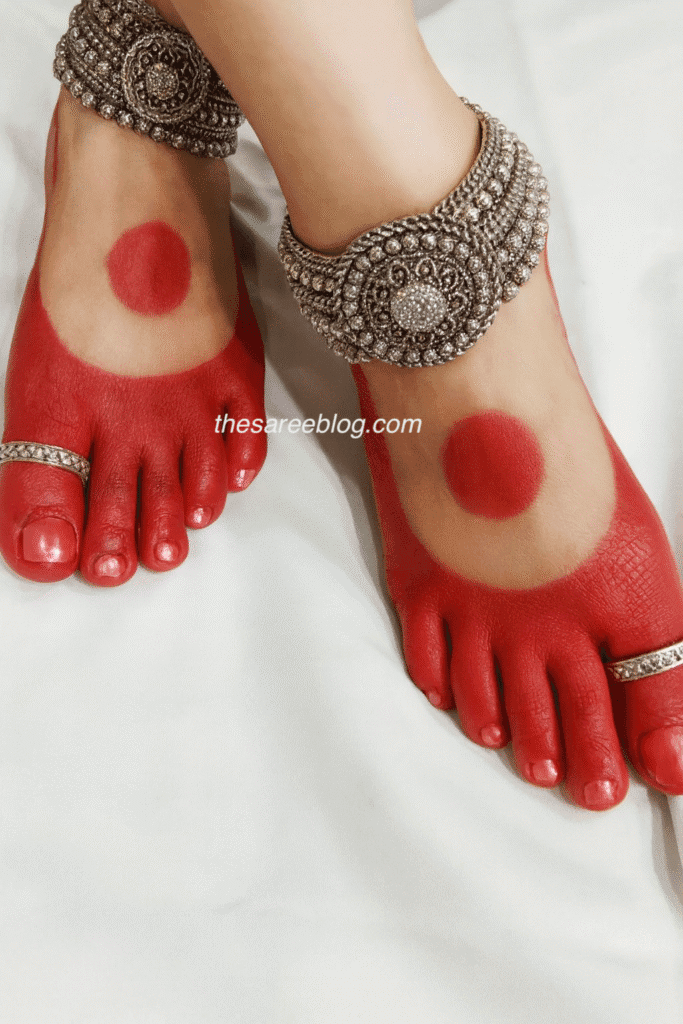
Artistic Variations
- Floral Motifs – Use cotton buds to create small flower-like designs on toes or arch.
- Border Outline – Instead of filling, just outline the edges of feet for a minimalist look.
- Diagonal Streaks – Brush slanted strokes across the feet, dramatic for dance or modern saree styling.
- Dual Tone Effect – Combine deep crimson aalta with lighter orange-red for layered shading.
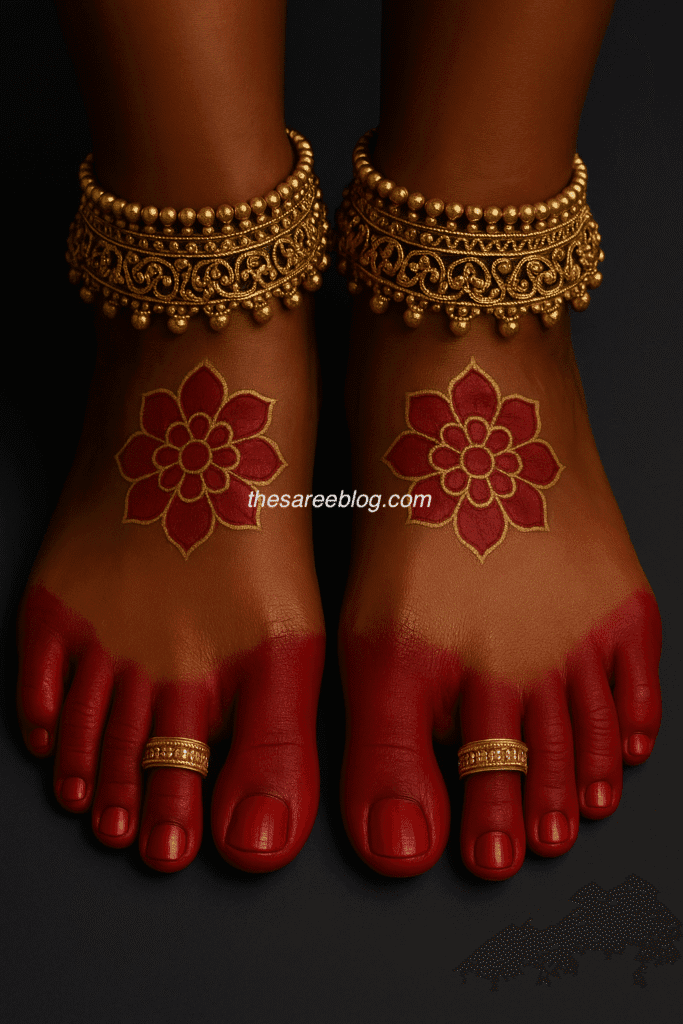
Fusion & Modern Twists
- Minimal Style – Just tips of toes in aalta, like a cultural “pedicure.”
- With Mehendi – Combine mehendi designs on the sole and highlight borders with aalta for a rich fusion.
- Jewelry Accents – Apply thin aalta lines where anklets or toe rings sit, enhancing ornaments.
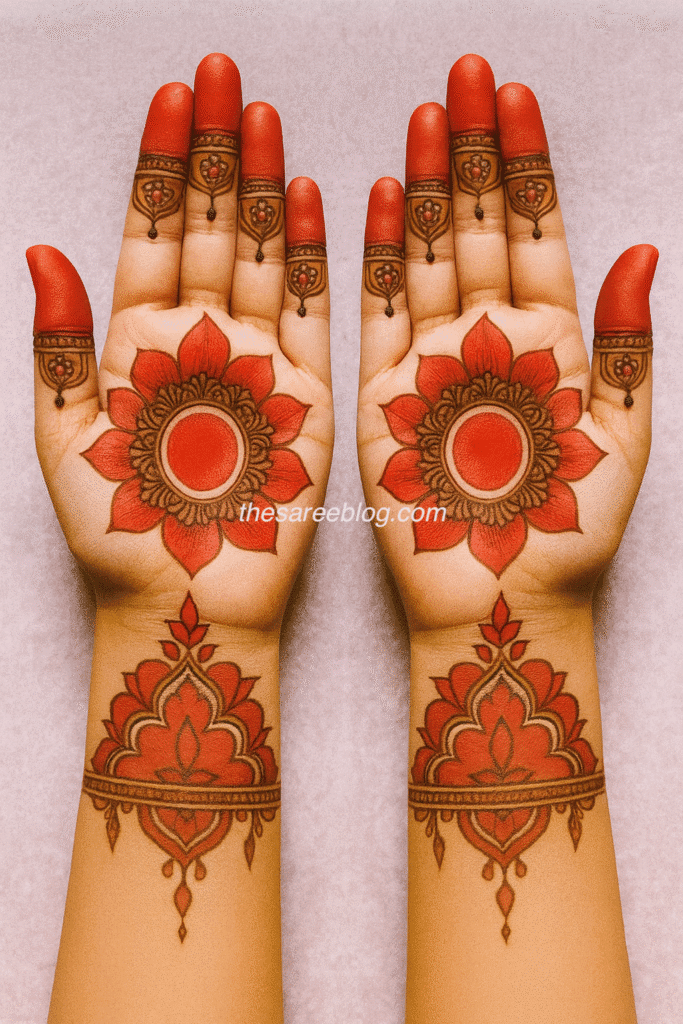
Pro Tip: Keep cotton buds or fine brushes handy to create neater, creative shapes. Traditional doesn’t have to mean plain — you can celebrate aalta in both ritualistic and fashion-forward ways.
Traditional Saree Styling with Aalta
- Bengali Sarees: Red-bordered taant or lal-paar sarees styled with aalta-stained feet, gold bangles, and a red bindi create the perfect festive look for Durga Puja.
- Bridal Silk Sarees: Aalta complements rich weaves like Banarasi, Kanjeevaram, and Paithani, especially when paired with kundan, temple jewelry, and heavy anklets. Brides wear aalta to symbolize fertility and prosperity.
- Puja Sarees: Simple white or cream sarees look divine with crimson aalta and sindoor, symbolizing purity and devotion.
Modern Saree Styling with Aalta
- Pastel Sarees: Aalta adds a striking contrast to blush pink, mint green, or ivory sarees. Minimal application, such as just outlining toes and heel, creates a chic balance.
- Fusion Sarees: With sarees styled as gowns, crop tops, or belt drapes, aalta adds a touch of rooted tradition to a contemporary silhouette.
- Cocktail Sarees: Sequinned or chiffon sarees paired with a subtle layer of aalta and metallic anklets bring Indo-western glamour.
- Minimalist Brides: For brides who prefer less mehendi, aalta helps create bold looks especially graceful with monochrome sarees like ivory-gold or black-red.
Styling Tips
- Coordinate nail polish with aalta for harmony.
- Pair silver jewelry with aalta for bohemian saree looks and gold jewelry for weddings.
- If your saree is heavily embellished, let the aalta be the main highlight by keeping the makeup soft.
Aalta vs Mehendi: Which One to Choose?
- Design: Mehendi offers intricate patterns, while aalta gives a bold single shade.
- Longevity: Mehendi lasts longer, while aalta fades quickly but can be reapplied.
- Use: Mehendi is mostly decorative, while aalta is ritualistic and symbolic.
Both remain important in Indian beauty traditions, but aalta carries a sharper connection with ritual sanctity.
Sustainability and Cultural Continuity
Traditionally, aalta was made using natural lac dye, which was eco-friendly and safe. With synthetic dyes dominating today, many women look for organic alternatives. Some small-scale artisans still prepare herbal aalta using natural lac, turmeric, and herbs. Supporting such artisans helps preserve both culture and sustainability.
Conclusion: The Eternal Red of Tradition
Aalta Shringar is not is ancient culture painted on the canvas of skin. Brides stepping into their new homes to dancers stepping onto the stage, aalta adds divine traditional beauty to your look.
In the fast-changing world of modern fashion, aalta remains timeless—a simple yet profound reminder of heritage. Wearing a saree for pooja or getting ready for a performance, the crimson dye continues tbe the symbolic of grace and strength of Indian womanhood. So, next time you go for a pooja, try a stunnig aalta design.

